Audit, Assurance and Compliance Report: DIPL, Finance Report
VerifiedAdded on 2020/03/02
|10
|2178
|469
Report
AI Summary
This report analyzes an audit, assurance, and compliance case study of Double Pink Printers Limited (DIPL). It examines the application of analytical methods, such as ratio analysis and benchmarking, in evaluating DIPL's financial performance. The report assesses current, profit margin, and solvency ratios, highlighting trends and implications for financial stability. It identifies inherent risk factors, including employee errors, inefficient workforce, and management issues, which contribute to fraud and financial reporting risks. Furthermore, the report discusses the types of risks, including fraud and financial reporting risks, and their explanations within the context of DIPL. The analysis emphasizes the importance of effective financial strategies and risk management to address identified issues and improve DIPL's financial health and compliance.

Running head: AUDIT, ASSURANCE AND COMPLIANCE
Audit, Assurance and Compliance
Name of the Student
Name of the University
Author’s Note
Audit, Assurance and Compliance
Name of the Student
Name of the University
Author’s Note
Paraphrase This Document
Need a fresh take? Get an instant paraphrase of this document with our AI Paraphraser
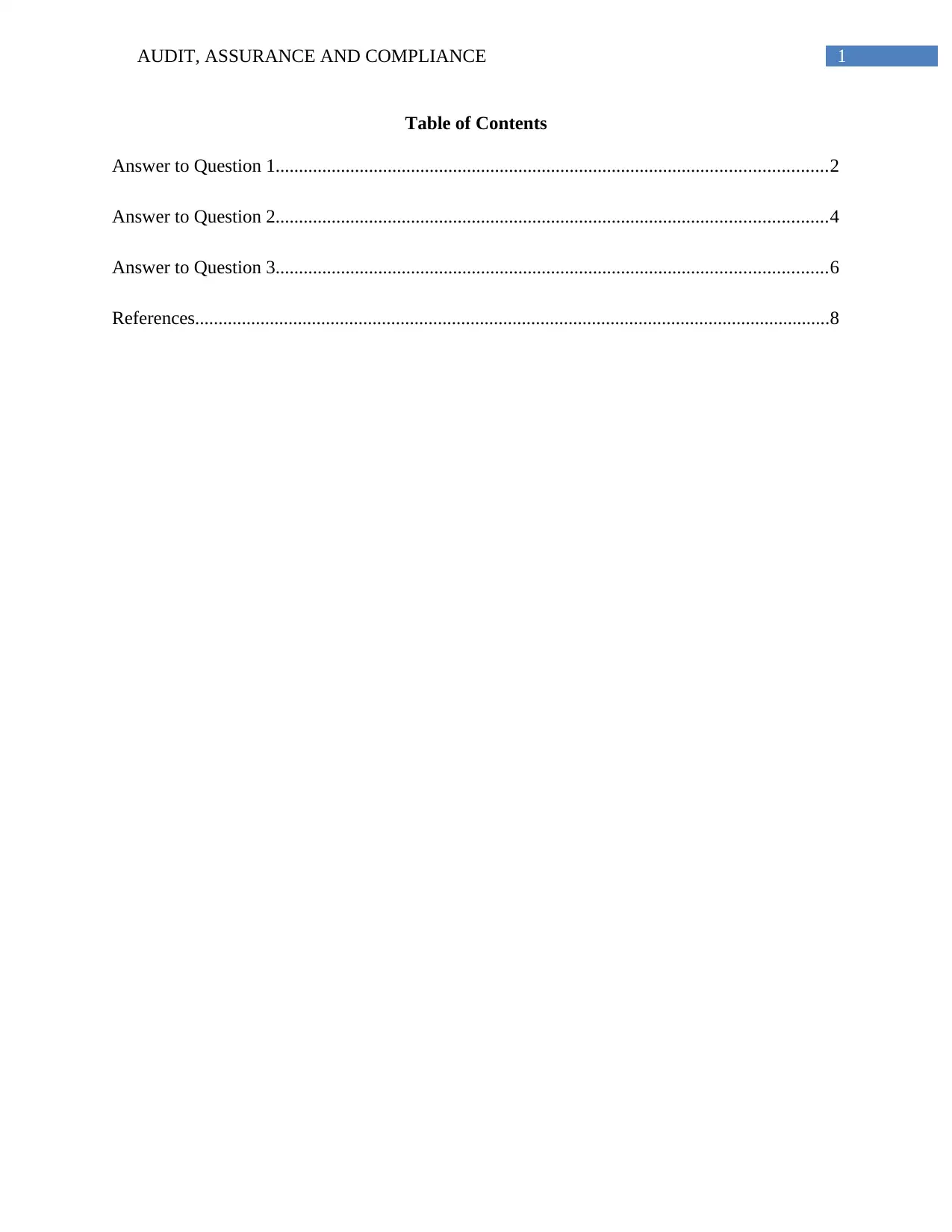
1AUDIT, ASSURANCE AND COMPLIANCE
Table of Contents
Answer to Question 1......................................................................................................................2
Answer to Question 2......................................................................................................................4
Answer to Question 3......................................................................................................................6
References........................................................................................................................................8
Table of Contents
Answer to Question 1......................................................................................................................2
Answer to Question 2......................................................................................................................4
Answer to Question 3......................................................................................................................6
References........................................................................................................................................8
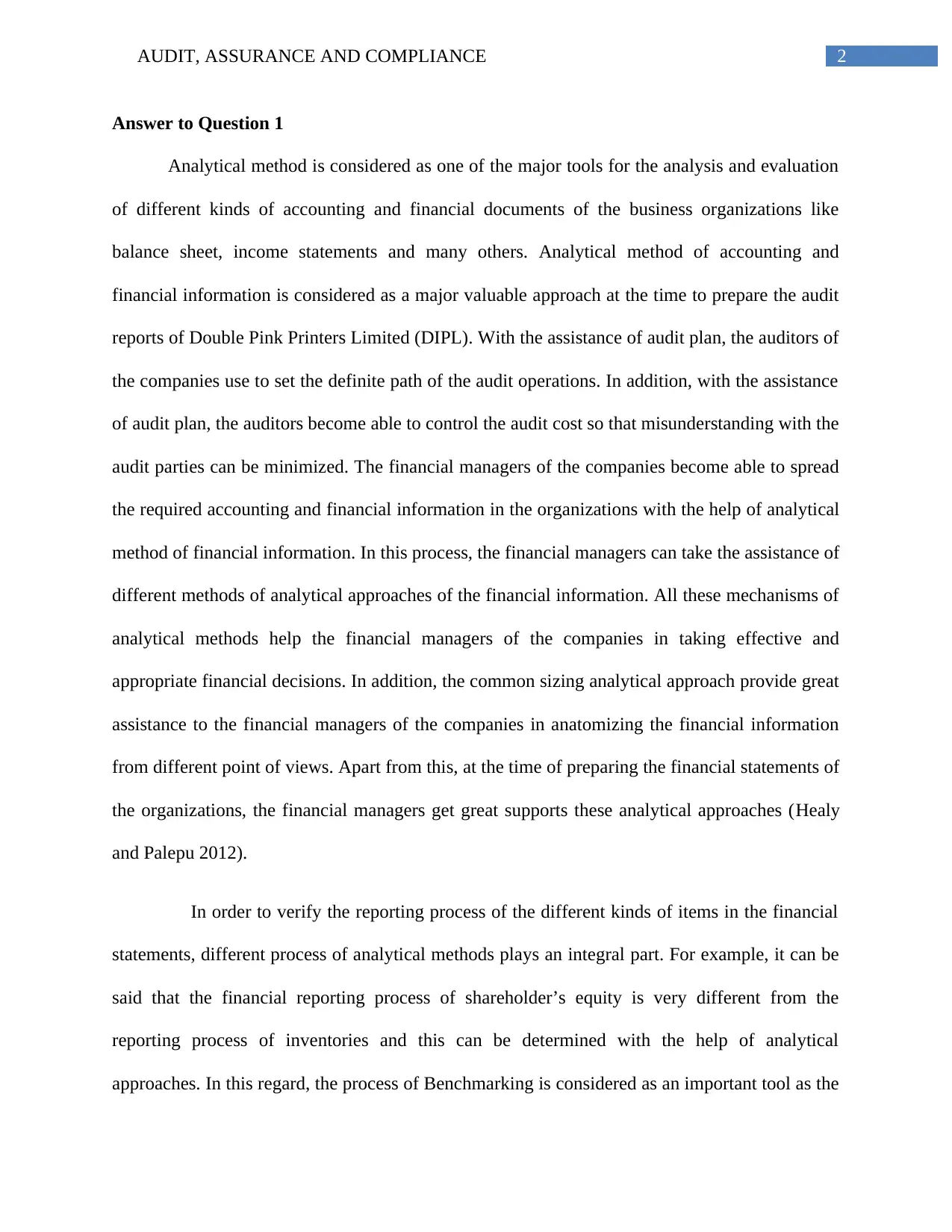
2AUDIT, ASSURANCE AND COMPLIANCE
Answer to Question 1
Analytical method is considered as one of the major tools for the analysis and evaluation
of different kinds of accounting and financial documents of the business organizations like
balance sheet, income statements and many others. Analytical method of accounting and
financial information is considered as a major valuable approach at the time to prepare the audit
reports of Double Pink Printers Limited (DIPL). With the assistance of audit plan, the auditors of
the companies use to set the definite path of the audit operations. In addition, with the assistance
of audit plan, the auditors become able to control the audit cost so that misunderstanding with the
audit parties can be minimized. The financial managers of the companies become able to spread
the required accounting and financial information in the organizations with the help of analytical
method of financial information. In this process, the financial managers can take the assistance of
different methods of analytical approaches of the financial information. All these mechanisms of
analytical methods help the financial managers of the companies in taking effective and
appropriate financial decisions. In addition, the common sizing analytical approach provide great
assistance to the financial managers of the companies in anatomizing the financial information
from different point of views. Apart from this, at the time of preparing the financial statements of
the organizations, the financial managers get great supports these analytical approaches (Healy
and Palepu 2012).
In order to verify the reporting process of the different kinds of items in the financial
statements, different process of analytical methods plays an integral part. For example, it can be
said that the financial reporting process of shareholder’s equity is very different from the
reporting process of inventories and this can be determined with the help of analytical
approaches. In this regard, the process of Benchmarking is considered as an important tool as the
Answer to Question 1
Analytical method is considered as one of the major tools for the analysis and evaluation
of different kinds of accounting and financial documents of the business organizations like
balance sheet, income statements and many others. Analytical method of accounting and
financial information is considered as a major valuable approach at the time to prepare the audit
reports of Double Pink Printers Limited (DIPL). With the assistance of audit plan, the auditors of
the companies use to set the definite path of the audit operations. In addition, with the assistance
of audit plan, the auditors become able to control the audit cost so that misunderstanding with the
audit parties can be minimized. The financial managers of the companies become able to spread
the required accounting and financial information in the organizations with the help of analytical
method of financial information. In this process, the financial managers can take the assistance of
different methods of analytical approaches of the financial information. All these mechanisms of
analytical methods help the financial managers of the companies in taking effective and
appropriate financial decisions. In addition, the common sizing analytical approach provide great
assistance to the financial managers of the companies in anatomizing the financial information
from different point of views. Apart from this, at the time of preparing the financial statements of
the organizations, the financial managers get great supports these analytical approaches (Healy
and Palepu 2012).
In order to verify the reporting process of the different kinds of items in the financial
statements, different process of analytical methods plays an integral part. For example, it can be
said that the financial reporting process of shareholder’s equity is very different from the
reporting process of inventories and this can be determined with the help of analytical
approaches. In this regard, the process of Benchmarking is considered as an important tool as the
⊘ This is a preview!⊘
Do you want full access?
Subscribe today to unlock all pages.

Trusted by 1+ million students worldwide
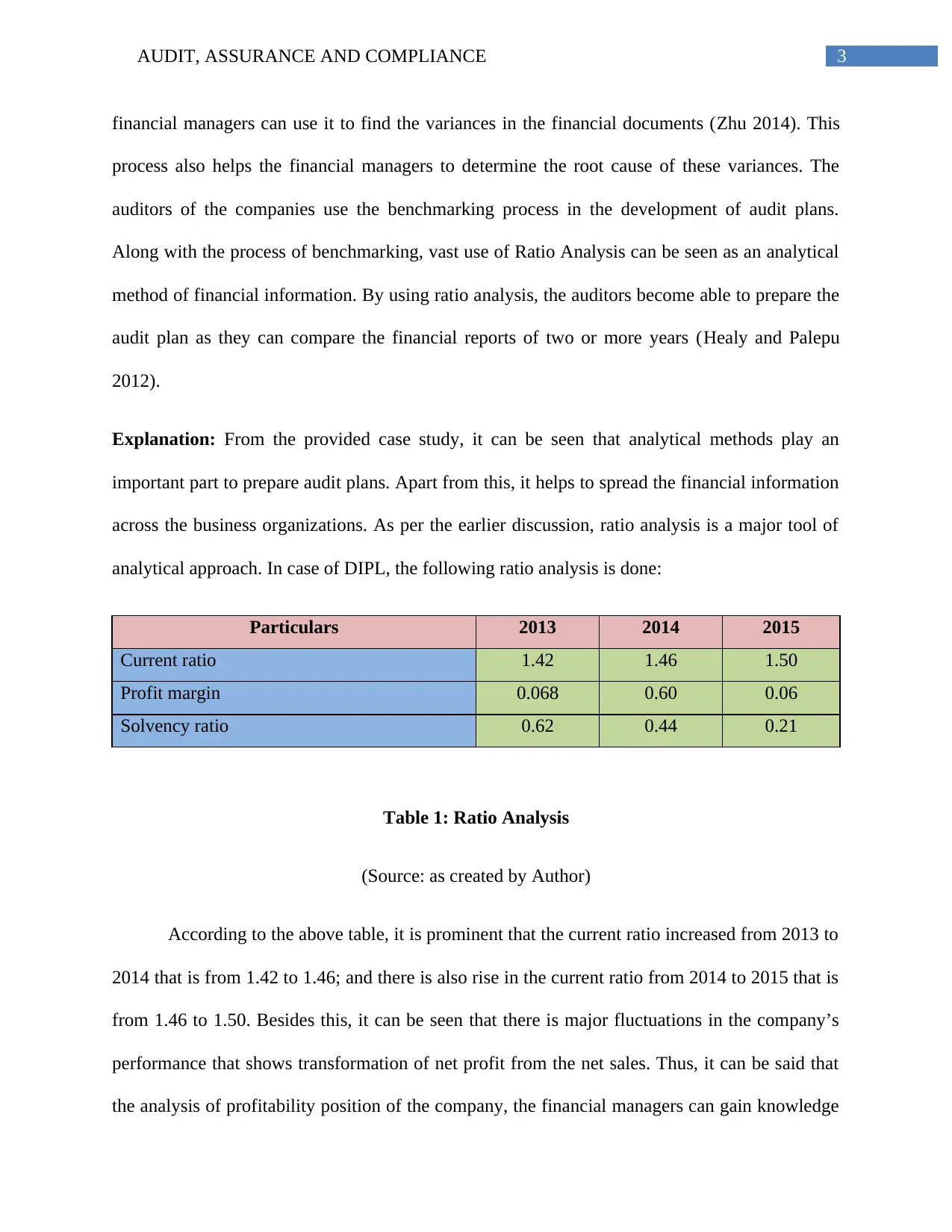
3AUDIT, ASSURANCE AND COMPLIANCE
financial managers can use it to find the variances in the financial documents (Zhu 2014). This
process also helps the financial managers to determine the root cause of these variances. The
auditors of the companies use the benchmarking process in the development of audit plans.
Along with the process of benchmarking, vast use of Ratio Analysis can be seen as an analytical
method of financial information. By using ratio analysis, the auditors become able to prepare the
audit plan as they can compare the financial reports of two or more years (Healy and Palepu
2012).
Explanation: From the provided case study, it can be seen that analytical methods play an
important part to prepare audit plans. Apart from this, it helps to spread the financial information
across the business organizations. As per the earlier discussion, ratio analysis is a major tool of
analytical approach. In case of DIPL, the following ratio analysis is done:
Particulars 2013 2014 2015
Current ratio 1.42 1.46 1.50
Profit margin 0.068 0.60 0.06
Solvency ratio 0.62 0.44 0.21
Table 1: Ratio Analysis
(Source: as created by Author)
According to the above table, it is prominent that the current ratio increased from 2013 to
2014 that is from 1.42 to 1.46; and there is also rise in the current ratio from 2014 to 2015 that is
from 1.46 to 1.50. Besides this, it can be seen that there is major fluctuations in the company’s
performance that shows transformation of net profit from the net sales. Thus, it can be said that
the analysis of profitability position of the company, the financial managers can gain knowledge
financial managers can use it to find the variances in the financial documents (Zhu 2014). This
process also helps the financial managers to determine the root cause of these variances. The
auditors of the companies use the benchmarking process in the development of audit plans.
Along with the process of benchmarking, vast use of Ratio Analysis can be seen as an analytical
method of financial information. By using ratio analysis, the auditors become able to prepare the
audit plan as they can compare the financial reports of two or more years (Healy and Palepu
2012).
Explanation: From the provided case study, it can be seen that analytical methods play an
important part to prepare audit plans. Apart from this, it helps to spread the financial information
across the business organizations. As per the earlier discussion, ratio analysis is a major tool of
analytical approach. In case of DIPL, the following ratio analysis is done:
Particulars 2013 2014 2015
Current ratio 1.42 1.46 1.50
Profit margin 0.068 0.60 0.06
Solvency ratio 0.62 0.44 0.21
Table 1: Ratio Analysis
(Source: as created by Author)
According to the above table, it is prominent that the current ratio increased from 2013 to
2014 that is from 1.42 to 1.46; and there is also rise in the current ratio from 2014 to 2015 that is
from 1.46 to 1.50. Besides this, it can be seen that there is major fluctuations in the company’s
performance that shows transformation of net profit from the net sales. Thus, it can be said that
the analysis of profitability position of the company, the financial managers can gain knowledge
Paraphrase This Document
Need a fresh take? Get an instant paraphrase of this document with our AI Paraphraser
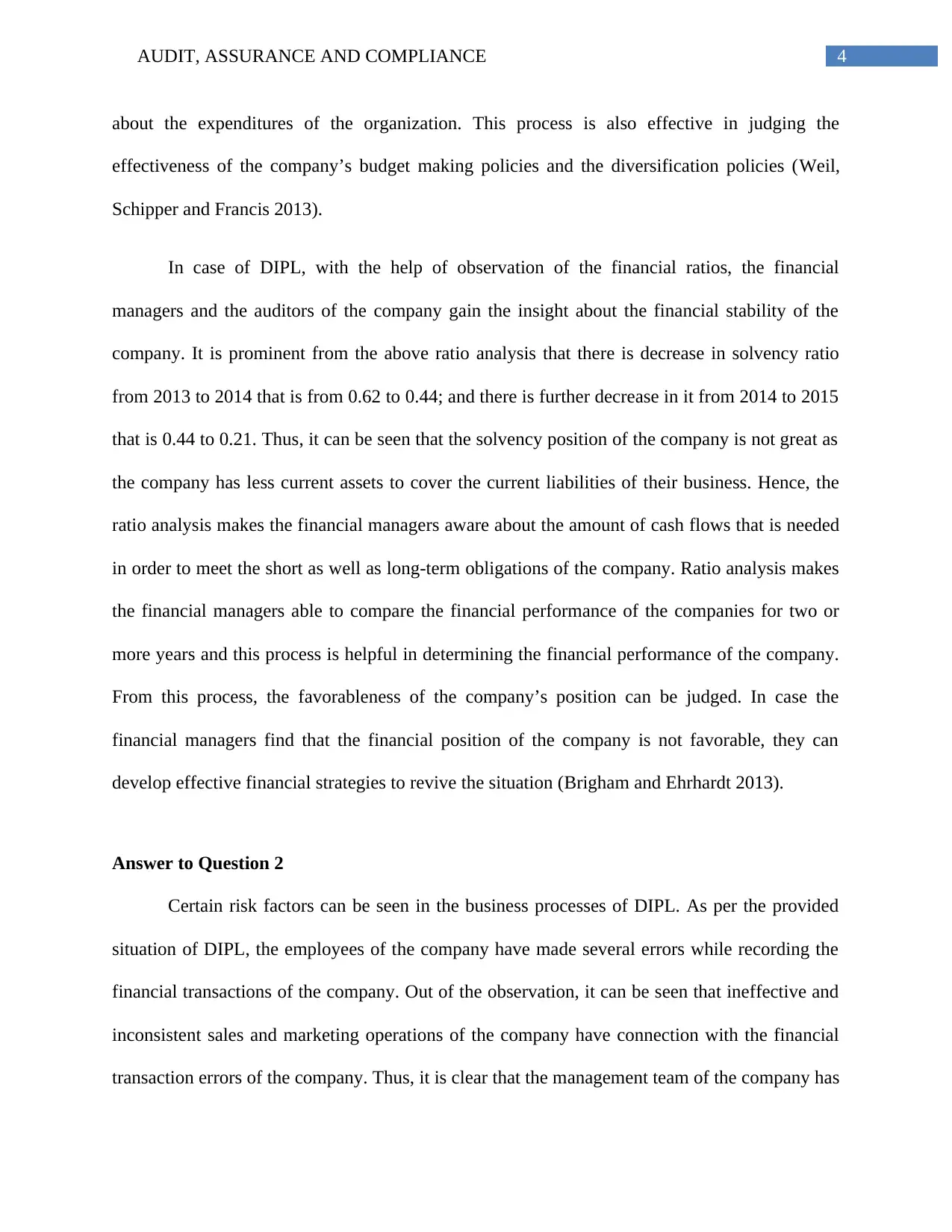
4AUDIT, ASSURANCE AND COMPLIANCE
about the expenditures of the organization. This process is also effective in judging the
effectiveness of the company’s budget making policies and the diversification policies (Weil,
Schipper and Francis 2013).
In case of DIPL, with the help of observation of the financial ratios, the financial
managers and the auditors of the company gain the insight about the financial stability of the
company. It is prominent from the above ratio analysis that there is decrease in solvency ratio
from 2013 to 2014 that is from 0.62 to 0.44; and there is further decrease in it from 2014 to 2015
that is 0.44 to 0.21. Thus, it can be seen that the solvency position of the company is not great as
the company has less current assets to cover the current liabilities of their business. Hence, the
ratio analysis makes the financial managers aware about the amount of cash flows that is needed
in order to meet the short as well as long-term obligations of the company. Ratio analysis makes
the financial managers able to compare the financial performance of the companies for two or
more years and this process is helpful in determining the financial performance of the company.
From this process, the favorableness of the company’s position can be judged. In case the
financial managers find that the financial position of the company is not favorable, they can
develop effective financial strategies to revive the situation (Brigham and Ehrhardt 2013).
Answer to Question 2
Certain risk factors can be seen in the business processes of DIPL. As per the provided
situation of DIPL, the employees of the company have made several errors while recording the
financial transactions of the company. Out of the observation, it can be seen that ineffective and
inconsistent sales and marketing operations of the company have connection with the financial
transaction errors of the company. Thus, it is clear that the management team of the company has
about the expenditures of the organization. This process is also effective in judging the
effectiveness of the company’s budget making policies and the diversification policies (Weil,
Schipper and Francis 2013).
In case of DIPL, with the help of observation of the financial ratios, the financial
managers and the auditors of the company gain the insight about the financial stability of the
company. It is prominent from the above ratio analysis that there is decrease in solvency ratio
from 2013 to 2014 that is from 0.62 to 0.44; and there is further decrease in it from 2014 to 2015
that is 0.44 to 0.21. Thus, it can be seen that the solvency position of the company is not great as
the company has less current assets to cover the current liabilities of their business. Hence, the
ratio analysis makes the financial managers aware about the amount of cash flows that is needed
in order to meet the short as well as long-term obligations of the company. Ratio analysis makes
the financial managers able to compare the financial performance of the companies for two or
more years and this process is helpful in determining the financial performance of the company.
From this process, the favorableness of the company’s position can be judged. In case the
financial managers find that the financial position of the company is not favorable, they can
develop effective financial strategies to revive the situation (Brigham and Ehrhardt 2013).
Answer to Question 2
Certain risk factors can be seen in the business processes of DIPL. As per the provided
situation of DIPL, the employees of the company have made several errors while recording the
financial transactions of the company. Out of the observation, it can be seen that ineffective and
inconsistent sales and marketing operations of the company have connection with the financial
transaction errors of the company. Thus, it is clear that the management team of the company has
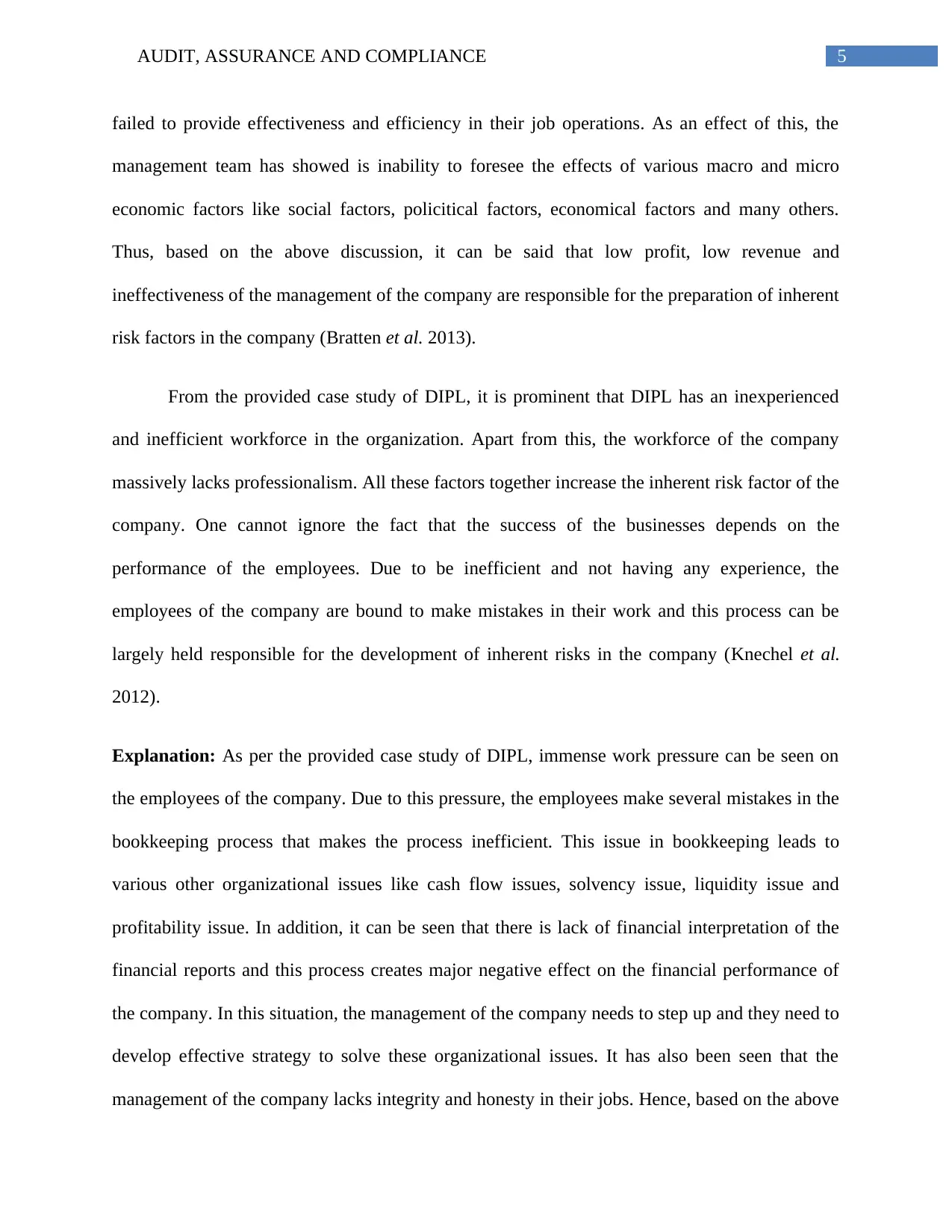
5AUDIT, ASSURANCE AND COMPLIANCE
failed to provide effectiveness and efficiency in their job operations. As an effect of this, the
management team has showed is inability to foresee the effects of various macro and micro
economic factors like social factors, policitical factors, economical factors and many others.
Thus, based on the above discussion, it can be said that low profit, low revenue and
ineffectiveness of the management of the company are responsible for the preparation of inherent
risk factors in the company (Bratten et al. 2013).
From the provided case study of DIPL, it is prominent that DIPL has an inexperienced
and inefficient workforce in the organization. Apart from this, the workforce of the company
massively lacks professionalism. All these factors together increase the inherent risk factor of the
company. One cannot ignore the fact that the success of the businesses depends on the
performance of the employees. Due to be inefficient and not having any experience, the
employees of the company are bound to make mistakes in their work and this process can be
largely held responsible for the development of inherent risks in the company (Knechel et al.
2012).
Explanation: As per the provided case study of DIPL, immense work pressure can be seen on
the employees of the company. Due to this pressure, the employees make several mistakes in the
bookkeeping process that makes the process inefficient. This issue in bookkeeping leads to
various other organizational issues like cash flow issues, solvency issue, liquidity issue and
profitability issue. In addition, it can be seen that there is lack of financial interpretation of the
financial reports and this process creates major negative effect on the financial performance of
the company. In this situation, the management of the company needs to step up and they need to
develop effective strategy to solve these organizational issues. It has also been seen that the
management of the company lacks integrity and honesty in their jobs. Hence, based on the above
failed to provide effectiveness and efficiency in their job operations. As an effect of this, the
management team has showed is inability to foresee the effects of various macro and micro
economic factors like social factors, policitical factors, economical factors and many others.
Thus, based on the above discussion, it can be said that low profit, low revenue and
ineffectiveness of the management of the company are responsible for the preparation of inherent
risk factors in the company (Bratten et al. 2013).
From the provided case study of DIPL, it is prominent that DIPL has an inexperienced
and inefficient workforce in the organization. Apart from this, the workforce of the company
massively lacks professionalism. All these factors together increase the inherent risk factor of the
company. One cannot ignore the fact that the success of the businesses depends on the
performance of the employees. Due to be inefficient and not having any experience, the
employees of the company are bound to make mistakes in their work and this process can be
largely held responsible for the development of inherent risks in the company (Knechel et al.
2012).
Explanation: As per the provided case study of DIPL, immense work pressure can be seen on
the employees of the company. Due to this pressure, the employees make several mistakes in the
bookkeeping process that makes the process inefficient. This issue in bookkeeping leads to
various other organizational issues like cash flow issues, solvency issue, liquidity issue and
profitability issue. In addition, it can be seen that there is lack of financial interpretation of the
financial reports and this process creates major negative effect on the financial performance of
the company. In this situation, the management of the company needs to step up and they need to
develop effective strategy to solve these organizational issues. It has also been seen that the
management of the company lacks integrity and honesty in their jobs. Hence, based on the above
⊘ This is a preview!⊘
Do you want full access?
Subscribe today to unlock all pages.

Trusted by 1+ million students worldwide
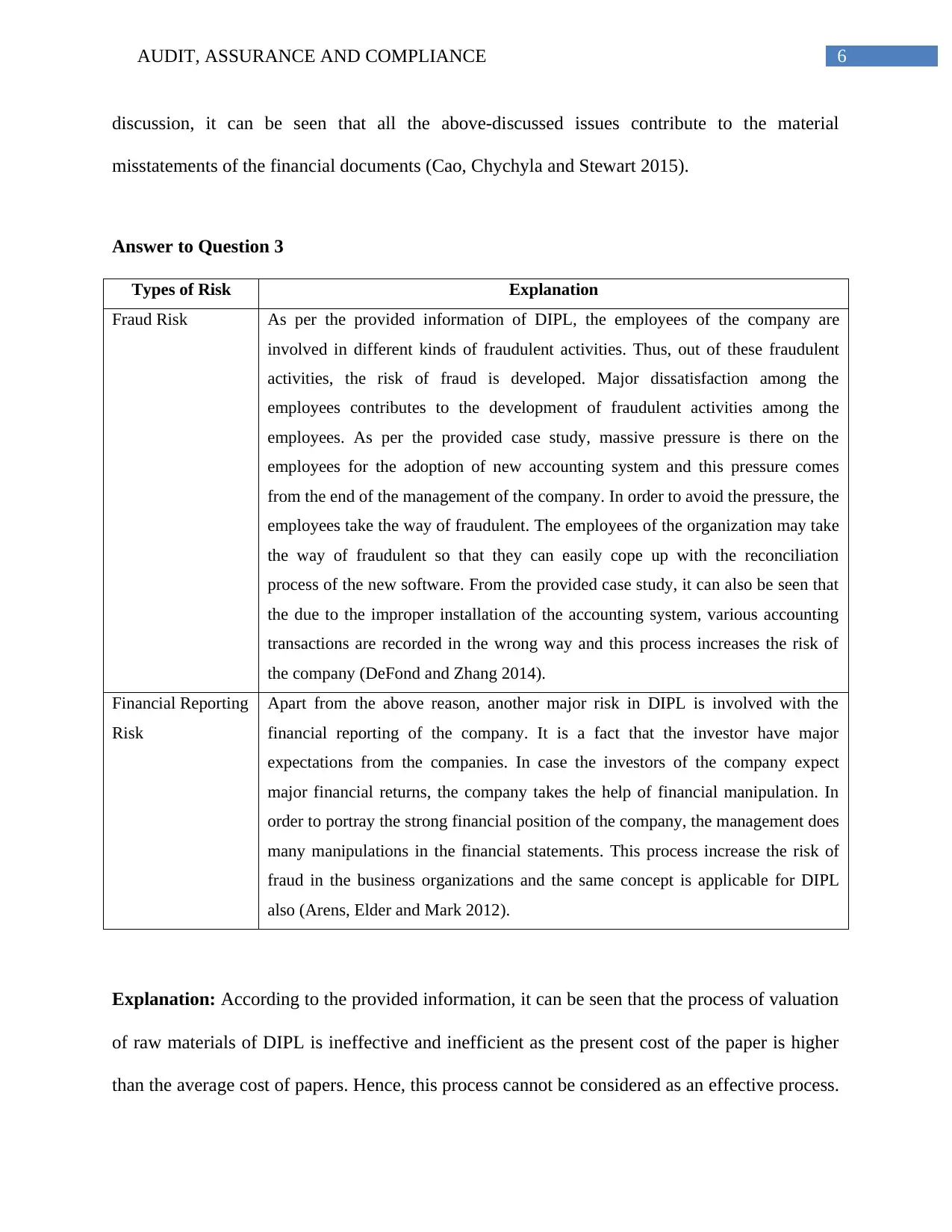
6AUDIT, ASSURANCE AND COMPLIANCE
discussion, it can be seen that all the above-discussed issues contribute to the material
misstatements of the financial documents (Cao, Chychyla and Stewart 2015).
Answer to Question 3
Types of Risk Explanation
Fraud Risk As per the provided information of DIPL, the employees of the company are
involved in different kinds of fraudulent activities. Thus, out of these fraudulent
activities, the risk of fraud is developed. Major dissatisfaction among the
employees contributes to the development of fraudulent activities among the
employees. As per the provided case study, massive pressure is there on the
employees for the adoption of new accounting system and this pressure comes
from the end of the management of the company. In order to avoid the pressure, the
employees take the way of fraudulent. The employees of the organization may take
the way of fraudulent so that they can easily cope up with the reconciliation
process of the new software. From the provided case study, it can also be seen that
the due to the improper installation of the accounting system, various accounting
transactions are recorded in the wrong way and this process increases the risk of
the company (DeFond and Zhang 2014).
Financial Reporting
Risk
Apart from the above reason, another major risk in DIPL is involved with the
financial reporting of the company. It is a fact that the investor have major
expectations from the companies. In case the investors of the company expect
major financial returns, the company takes the help of financial manipulation. In
order to portray the strong financial position of the company, the management does
many manipulations in the financial statements. This process increase the risk of
fraud in the business organizations and the same concept is applicable for DIPL
also (Arens, Elder and Mark 2012).
Explanation: According to the provided information, it can be seen that the process of valuation
of raw materials of DIPL is ineffective and inefficient as the present cost of the paper is higher
than the average cost of papers. Hence, this process cannot be considered as an effective process.
discussion, it can be seen that all the above-discussed issues contribute to the material
misstatements of the financial documents (Cao, Chychyla and Stewart 2015).
Answer to Question 3
Types of Risk Explanation
Fraud Risk As per the provided information of DIPL, the employees of the company are
involved in different kinds of fraudulent activities. Thus, out of these fraudulent
activities, the risk of fraud is developed. Major dissatisfaction among the
employees contributes to the development of fraudulent activities among the
employees. As per the provided case study, massive pressure is there on the
employees for the adoption of new accounting system and this pressure comes
from the end of the management of the company. In order to avoid the pressure, the
employees take the way of fraudulent. The employees of the organization may take
the way of fraudulent so that they can easily cope up with the reconciliation
process of the new software. From the provided case study, it can also be seen that
the due to the improper installation of the accounting system, various accounting
transactions are recorded in the wrong way and this process increases the risk of
the company (DeFond and Zhang 2014).
Financial Reporting
Risk
Apart from the above reason, another major risk in DIPL is involved with the
financial reporting of the company. It is a fact that the investor have major
expectations from the companies. In case the investors of the company expect
major financial returns, the company takes the help of financial manipulation. In
order to portray the strong financial position of the company, the management does
many manipulations in the financial statements. This process increase the risk of
fraud in the business organizations and the same concept is applicable for DIPL
also (Arens, Elder and Mark 2012).
Explanation: According to the provided information, it can be seen that the process of valuation
of raw materials of DIPL is ineffective and inefficient as the present cost of the paper is higher
than the average cost of papers. Hence, this process cannot be considered as an effective process.
Paraphrase This Document
Need a fresh take? Get an instant paraphrase of this document with our AI Paraphraser
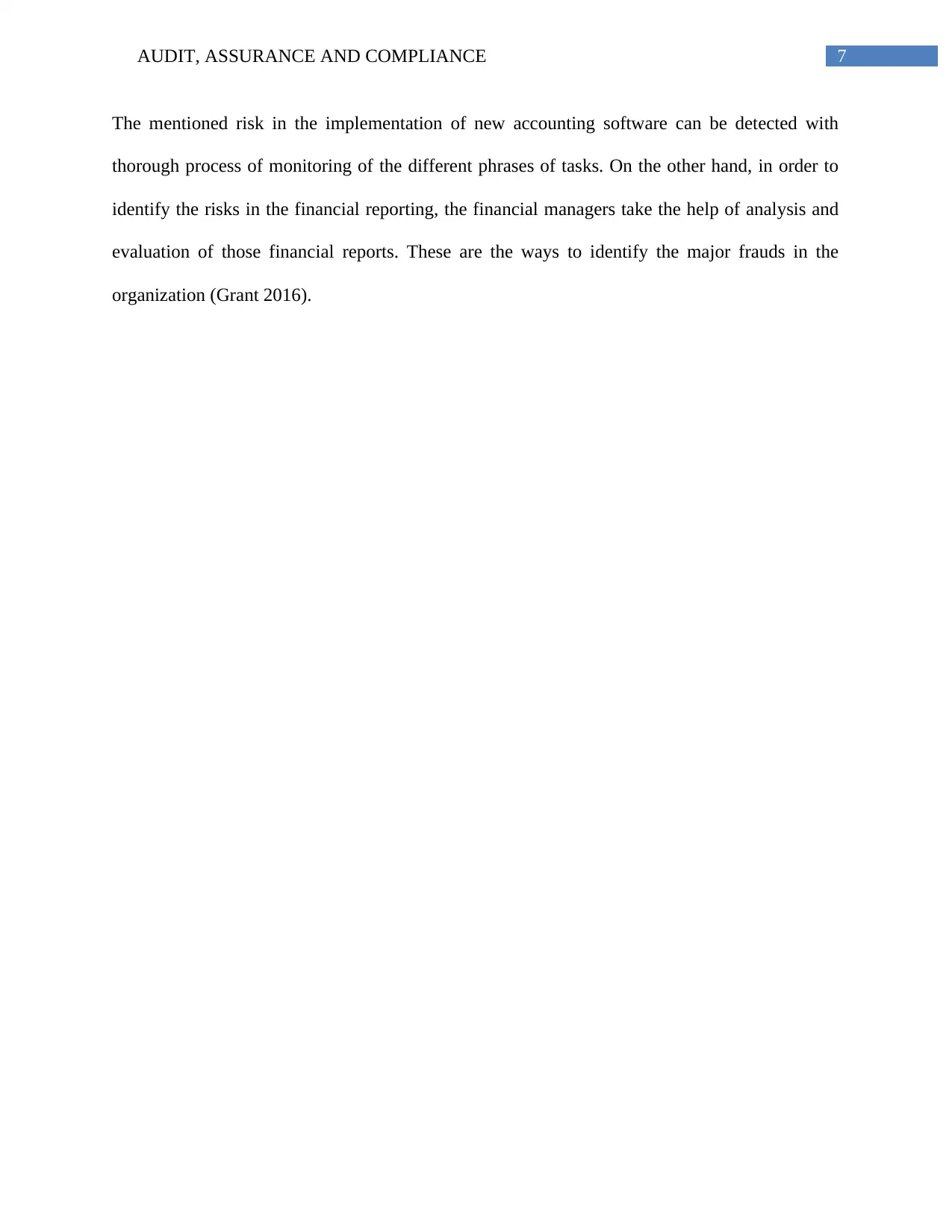
7AUDIT, ASSURANCE AND COMPLIANCE
The mentioned risk in the implementation of new accounting software can be detected with
thorough process of monitoring of the different phrases of tasks. On the other hand, in order to
identify the risks in the financial reporting, the financial managers take the help of analysis and
evaluation of those financial reports. These are the ways to identify the major frauds in the
organization (Grant 2016).
The mentioned risk in the implementation of new accounting software can be detected with
thorough process of monitoring of the different phrases of tasks. On the other hand, in order to
identify the risks in the financial reporting, the financial managers take the help of analysis and
evaluation of those financial reports. These are the ways to identify the major frauds in the
organization (Grant 2016).
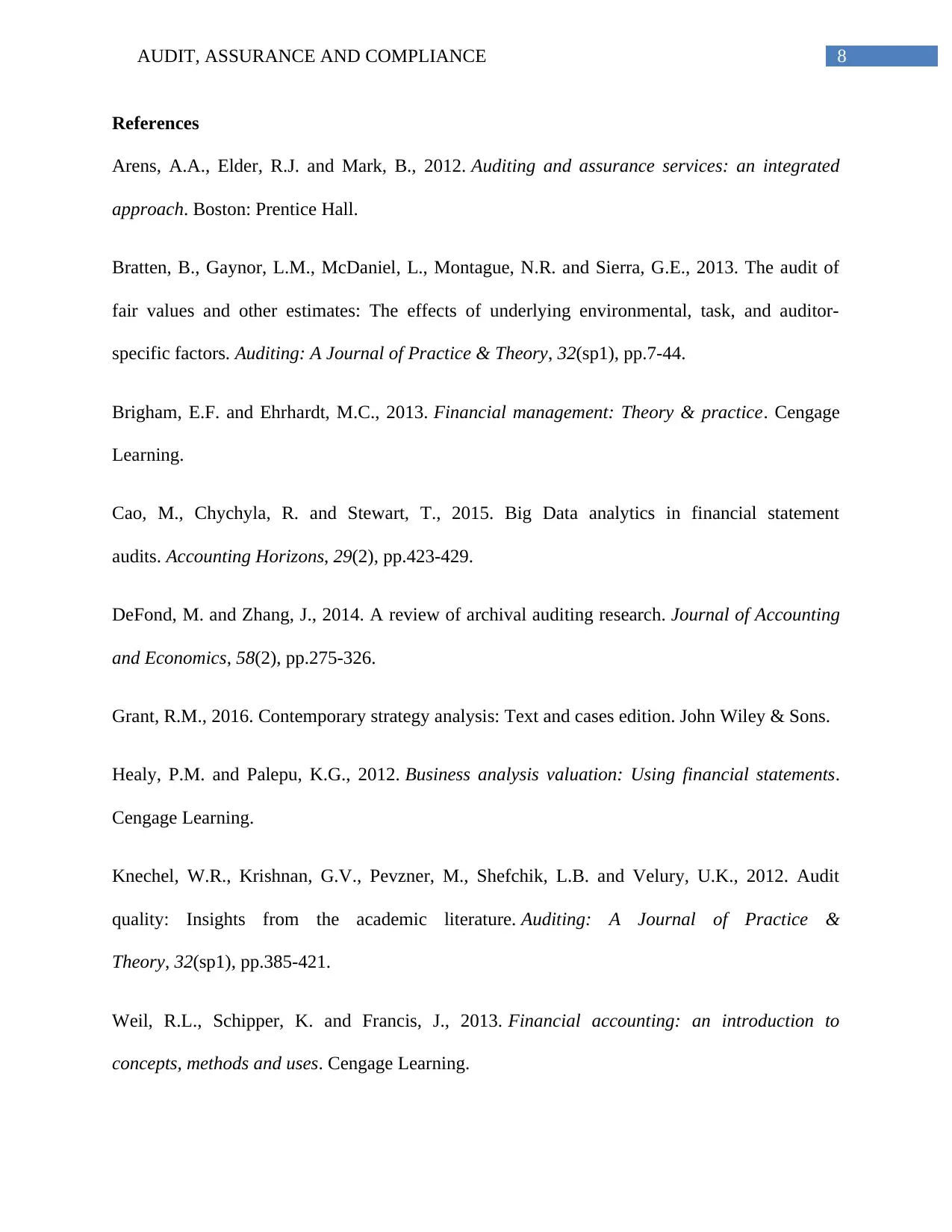
8AUDIT, ASSURANCE AND COMPLIANCE
References
Arens, A.A., Elder, R.J. and Mark, B., 2012. Auditing and assurance services: an integrated
approach. Boston: Prentice Hall.
Bratten, B., Gaynor, L.M., McDaniel, L., Montague, N.R. and Sierra, G.E., 2013. The audit of
fair values and other estimates: The effects of underlying environmental, task, and auditor-
specific factors. Auditing: A Journal of Practice & Theory, 32(sp1), pp.7-44.
Brigham, E.F. and Ehrhardt, M.C., 2013. Financial management: Theory & practice. Cengage
Learning.
Cao, M., Chychyla, R. and Stewart, T., 2015. Big Data analytics in financial statement
audits. Accounting Horizons, 29(2), pp.423-429.
DeFond, M. and Zhang, J., 2014. A review of archival auditing research. Journal of Accounting
and Economics, 58(2), pp.275-326.
Grant, R.M., 2016. Contemporary strategy analysis: Text and cases edition. John Wiley & Sons.
Healy, P.M. and Palepu, K.G., 2012. Business analysis valuation: Using financial statements.
Cengage Learning.
Knechel, W.R., Krishnan, G.V., Pevzner, M., Shefchik, L.B. and Velury, U.K., 2012. Audit
quality: Insights from the academic literature. Auditing: A Journal of Practice &
Theory, 32(sp1), pp.385-421.
Weil, R.L., Schipper, K. and Francis, J., 2013. Financial accounting: an introduction to
concepts, methods and uses. Cengage Learning.
References
Arens, A.A., Elder, R.J. and Mark, B., 2012. Auditing and assurance services: an integrated
approach. Boston: Prentice Hall.
Bratten, B., Gaynor, L.M., McDaniel, L., Montague, N.R. and Sierra, G.E., 2013. The audit of
fair values and other estimates: The effects of underlying environmental, task, and auditor-
specific factors. Auditing: A Journal of Practice & Theory, 32(sp1), pp.7-44.
Brigham, E.F. and Ehrhardt, M.C., 2013. Financial management: Theory & practice. Cengage
Learning.
Cao, M., Chychyla, R. and Stewart, T., 2015. Big Data analytics in financial statement
audits. Accounting Horizons, 29(2), pp.423-429.
DeFond, M. and Zhang, J., 2014. A review of archival auditing research. Journal of Accounting
and Economics, 58(2), pp.275-326.
Grant, R.M., 2016. Contemporary strategy analysis: Text and cases edition. John Wiley & Sons.
Healy, P.M. and Palepu, K.G., 2012. Business analysis valuation: Using financial statements.
Cengage Learning.
Knechel, W.R., Krishnan, G.V., Pevzner, M., Shefchik, L.B. and Velury, U.K., 2012. Audit
quality: Insights from the academic literature. Auditing: A Journal of Practice &
Theory, 32(sp1), pp.385-421.
Weil, R.L., Schipper, K. and Francis, J., 2013. Financial accounting: an introduction to
concepts, methods and uses. Cengage Learning.
⊘ This is a preview!⊘
Do you want full access?
Subscribe today to unlock all pages.

Trusted by 1+ million students worldwide
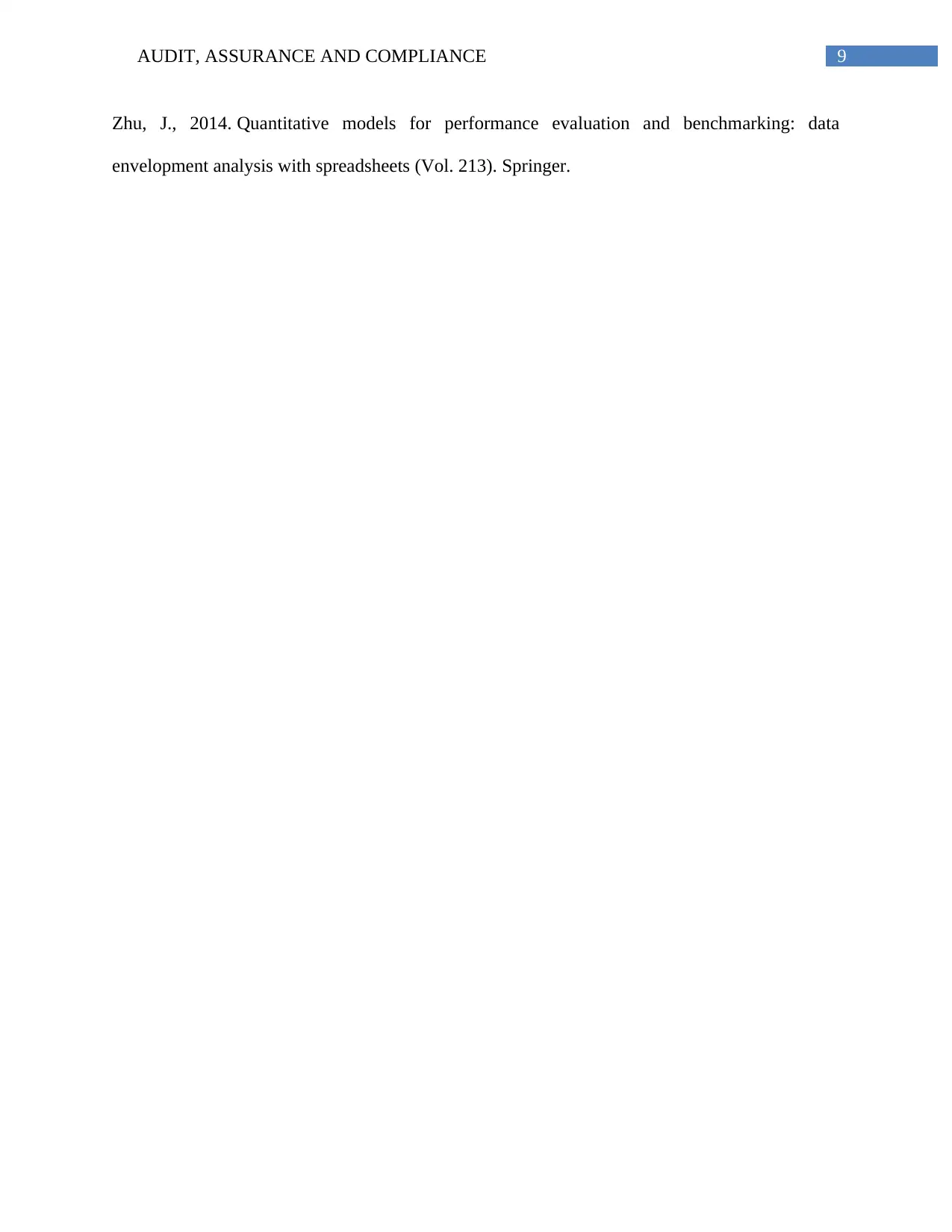
9AUDIT, ASSURANCE AND COMPLIANCE
Zhu, J., 2014. Quantitative models for performance evaluation and benchmarking: data
envelopment analysis with spreadsheets (Vol. 213). Springer.
Zhu, J., 2014. Quantitative models for performance evaluation and benchmarking: data
envelopment analysis with spreadsheets (Vol. 213). Springer.
1 out of 10
Related Documents
Your All-in-One AI-Powered Toolkit for Academic Success.
+13062052269
info@desklib.com
Available 24*7 on WhatsApp / Email
![[object Object]](/_next/static/media/star-bottom.7253800d.svg)
Unlock your academic potential
Copyright © 2020–2025 A2Z Services. All Rights Reserved. Developed and managed by ZUCOL.





